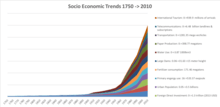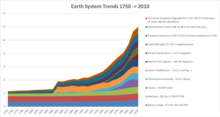Great Acceleration
The Great Acceleration refers to the most recent period of the Anthropocene during which the rate of impact of human activity upon the Earth's geology and ecosystems is increasing significantly. While the Anthropocene commenced with Industrial Revolution if not long before, the Great Acceleration begins in the 20th century with the acceleration rate dramatically increasing after the Second World War.[1] This concept has been further extended to refer to the rate of change in technology and society as a whole.[2]
Overview
In tracking the effects of human activity upon the Earth, a number of socioeconomic and earth system parameters are utilized including population, economics, water usage, food production, transportation, technology, green house gases, surface temperature, and natural resource usage.[3] The Anthropocene is typically depicted as following the Holocene, to emphasize the central role of humankind in geology and ecology.[1] Since 1950, these trends are increasing significantly if not exponentially.[4]
Great Acceleration Data Classification Categories
The international Geosphere-Biosphere Programme has divided and analyzed data from years 1750 to 2010 into two broad categories each with 12 subcategories.[5] The first category of socioeconomic trend data illustrates the impact on the second, the earth system trend data.
Socioeconomic trends

- Population
- Real GDP
- Foreign Direct Investment
- Urban population
- Primary energy use
- Fertiliser consumption
- Large dams
- Water use
- Paper production
- Transportation
- Telecommunications
- International Tourism
Earth System Trends

- Carbon dioxide
- Nitrous oxide
- Methane
- Stratospheric ozone
- Surface temperature
- Ocean acidification
- Marine fish capture
- Shrimp aquaculture
- Nitrogen to coastal zone
- Tropical forest loss
- Domesticated land
- Terrestrial biosphere degradation
References
| Wikiquote has quotations related to: Great Acceleration |
- 1 2 Mcneill, J. R. (2014). The Great Acceleration: An Environmental History of the Anthropocene since 1945. Cambridge: Harvard University Press. ISBN 0674545036.
- ↑ COLVILE, ROBERT. The Great Acceleration: how the world is getting faster and faster. London: Bloomsbury. ISBN 9781408840214.
- ↑ Steffen, Will; Crutzen, Paul J.; McNeill, John R. (2007). "The Anthropocene: Are Humans Now Overwhelming the Great Forces of Nature?". Ambio. 36 (8): 614–621.
- ↑ ANTHROPOCENE. "Welcome to the Anthropocene". Welcome to the Anthropocene. Retrieved March 10, 2018.
- ↑ Broadgate, Wendy; et al. "The Great Acceleration data (October 2014)". International Geosphere-Biosphere Programme. Retrieved 21 April 2018.